Modeling Climate Regulation of Arable Soils in Northern Saxony under the Influence of Climate Change and Management Practices
Abstract
1. Introduction
1.1. Climate Change and the Role of SCS in the Agricultural Sector
1.2. Modeling SOC Stocks for Different Regions and Scenarios
1.3. Scope of This Study
2. Materials and Methods
2.1. Study Area
2.2. The CCB Model
2.3. Input Data, Model Set-Up and Initialisation
2.4. Scenario Development and Model Application
2.5. Analysis of Driving Factors
3. Results
3.1. Scenario Results
3.2. Sensitivity of Driving Factors
4. Discussion
4.1. Increase in SOC Stocks under Different Scenarios
4.2. Effects of the Driving Factors
4.3. Implications of This Study
4.4. Limitations and Outlook
5. Conclusions
Supplementary Materials
Author Contributions
Funding
Institutional Review Board Statement
Informed Consent Statement
Data Availability Statement
Acknowledgments
Conflicts of Interest
References
- Intergovernmental Panel on Climate Change. Summary for Policymakers. In Climate Change and Land: An IPCC Special Report on Climate Change, Desertification, Land Degradation, Sustainable Land Management, Food Security, and Greenhouse Gas Fluxes in Terrestrial Ecosystems; Intergovernmental Panel on Climate Change, Ed.; Cambridge University Press: Cambridge, UK; New York, NY, USA, 2019; pp. 1–36. [Google Scholar]
- Intergovernmental Panel on Climate Change. Climate Change 2014: Synthesis Report; Contribution of Working Groups I, II and III to the Fifth Assessment Report of the Intergovernmental Panel on Climate Change: Geneva, Switzerland, 2014. [Google Scholar]
- Paustian, K.; Lehmann, J.; Ogle, S.; Reay, D.; Robertson, G.P.; Smith, P. Climate-smart soils. Nature 2016, 532, 49–57. [Google Scholar] [CrossRef] [PubMed]
- Mandal, A.; Majumder, A.; Dhaliwal, S.S.; Toor, A.S.; Mani, P.K.; Naresh, R.K.; Gupta, R.K.; Mitran, T. Impact of agricultural management practices on soil carbon sequestration and its monitoring through simulation models and remote sensing techniques: A review. Crit. Rev. Environ. Sci. Technol. 2022, 52, 1–49. [Google Scholar] [CrossRef]
- Paustian, K.; Larson, E.; Kent, J.; Marx, E.; Swan, A. Soil C Sequestration as a Biological Negative Emission Strategy. Front. Clim. 2019, 1, 8. [Google Scholar] [CrossRef]
- McDonald, H.; Frelih-Larsen, A.; Lorant, A.; Duin, L.; Pyndt Andersen, S.; Costa, G.; Bradley, H. Carbon Farming: Making Agriculture Fit for 2030; Study for the committee on Environment, Public Health and Food Safety (ENVI) PE 695.482; Policy Department for Economic, Scientific and Quality of Life Policies, European Parliament: Luxembourg, 2021; Available online: https://www.europarl.europa.eu/RegData/etudes/STUD/2021/695482/IPOL_STU(2021)695482_EN.pdf (accessed on 21 October 2022).
- Franko, U.; Diel, J.; Ruehlmann, J. Applying CCB to predict management change affected long-term SOM turnover of the Extended Static Fertilization Experiment in Bad Lauchstädt. Eur. J. Soil Sci. 2021, 73, e13148. [Google Scholar]
- Smith, P.; Smith, J.U.; Franko, U.; Kuka, K.; Romanenkov, V.A.; Shevtsova, L.K.; Wattenbach, M.; Gottschalk, P.; Sirotenko, O.D.; Rukhovich, D.I.; et al. Changes in mineral soil organic carbon stocks in the croplands of European Russia and the Ukraine, 1990–2070; comparison of three models and implications for climate mitigation. Reg. Environ. Chang. 2007, 7, 105–119. [Google Scholar] [CrossRef]
- Witing, F.; Gebel, M.; Kurzer, H.-J.; Friese, H.; Franko, U. Large-scale integrated assessment of soil carbon and organic matter-related nitrogen fluxes in Saxony (Germany). J. Environ. Manag. 2019, 237, 272–280. [Google Scholar] [CrossRef]
- Zhao, G.; Bryan, B.A.; King, D.; Luo, Z.; Wang, E.; Song, X.; Yu, Q. Impact of agricultural management practices on soil organic carbon: Simulation of Australian wheat systems. Glob. Chang. Biol. 2013, 19, 1585–1597. [Google Scholar] [CrossRef]
- Lessmann, M.; Ros, G.H.; Young, M.D.; de Vries, W. Global variation in soil carbon sequestration potential through improved cropland management. Glob. Chang. Biol. 2022, 28, 1162–1177. [Google Scholar] [CrossRef]
- Searchinger, T.; Waite, R.; Hanson, C.; Ranganathan, J. Creating a Sustainable Food Future: A Menu of Solutions to Feed Nearly 10 Billion People by 2050; Final Report; World Resources Institute: Washington, DC, USA, 2019. [Google Scholar]
- Food and Agricultural Organization of the United Nations. Measuring and Modelling Soil Carbon Stocks and Stock Changes in Livestock Production Systems: Guidelines for Assessment; Version 1; Livestock Environmental Assessment and Performance (LEAP) Partnership: Rome, Italy, 2019. [Google Scholar]
- Amelung, W.; Bossio, D.; de Vries, W.; Kögel-Knabner, I.; Lehmann, J.; Amundson, R.; Bol, R.; Collins, C.; Lal, R.; Leifeld, J.; et al. Towards a global-scale soil climate mitigation strategy. Nat. Commun. 2020, 11, 5427. [Google Scholar] [CrossRef]
- Kriegler, E.; O’neill, B.C.; Hallegatte, S.; Kram, T.; Lempert, R.J.; Moss, R.H.; Wilbanks, T. The need for and use of socio-economic scenarios for climate change analysis: A new approach based on shared socio-economic pathways. Glob. Environ. Chang. 2012, 22, 807–822. [Google Scholar] [CrossRef]
- Pastor, A.V.; Nunes, J.P.; Ciampalini, R.; Bahri, H.; Annabi, M.; Chikhaoui, M.; Crabit, A.; Follain, S.; Keizer, J.J.; Latron, J.; et al. ScenaLand: A simple methodology for developing land use and management scenarios. Mitig. Adapt. Strat. Glob. Chang. 2022, 27, 52. [Google Scholar] [CrossRef]
- Gutzler, C.; Helming, K.; Balla, D.; Dannowski, R.; Deumlich, D.; Glemnitz, M.; Knierim, A.; Mirschel, W.; Nendel, C.; Paul, C.; et al. Agricultural land use changes—A scenario-based sustainability impact assessment for Brandenburg, Germany. Ecol. Indic. 2015, 48, 505–517. [Google Scholar] [CrossRef]
- Landesamt Für Umwelt, Landwirtschaft und Geologie. Die Vergleichsgebiete in Sachsen: Zusammenstellung Standörtlicher Bedingungen Für Die Landwirtschaft und Flächennutzung. 2012. Available online: https://www.landwirtschaft.sachsen.de/download/RAWIS_Natuerliche_Bedingungen_VG.pdf (accessed on 26 October 2022).
- Sächsisches Staatsministerium für Energie, Klimaschutz, Umwelt und Landwirtschaft. Vergleichsgebiet 10—Dübener-Dahlener Heide. Available online: https://www.landwirtschaft.sachsen.de/vergleichsgebiet-10-duebener-dahlener-heide-15205.html (accessed on 26 October 2022).
- Lülfs-Baden, F.; Barrett, S.; Schulze Höping, M.; Stahl, H. Situation der Bodenbearbeitung in Sachsen: Eine Analyse zur Verbreitung Verschiedener Bodenbearbeitungsverfahren und der Damit Verbundenen Technischen Ausstattung; Schriftenreihe des LfULG Heft 5; Landesamt für Umwelt, Landwirtschaft und Geologie: Dresden, Germany, 2020. [Google Scholar]
- Sächsisches Staatsministerium für Energie, Klimaschutz, Umwelt und Landwirtschaft. Boden-Klima-Räume. Available online: https://www.landwirtschaft.sachsen.de/boden-klima-raeume-15281.html (accessed on 26 October 2022).
- Landesamt für Umwelt, Landwirtschaft und Geologie. Böden der Altmoränenlandschaften. Available online: https://www.boden.sachsen.de/boden-der-altmoranenlandschaften-17982.html (accessed on 16 October 2022).
- Sächsisches Staatsministerium für Energie, Klimaschutz, Umwelt und Landwirtschaft. Integriertes Verwaltungs- und Kontrollsystem (InVeKoS) Sachsen. 2020. Available online: https://www.smekul.sachsen.de/ (accessed on 11 October 2022).
- Forschung für Nachhaltigkeit. ECO²SCAPE—Partizipativer Biodiversitätsschutz Durch Verbindung ökologischer und ökonomischer Perspektiven. Available online: https://www.fona.de/de/aktuelles/nachrichten/2021/eco2scape.php (accessed on 25 July 2022).
- Hölting, L.; Komossa, F.; Filyushkina, A.; Gastinger, M.-M.; Verburg, P.H.; Beckmann, M.; Volk, M.; Cord, A.F. Including stakeholders’ perspectives on ecosystem services in multifunctionality assessments. Ecosyst. People 2020, 16, 354–368. [Google Scholar] [CrossRef]
- Franko, U.; Kolbe, H.; Thiel, E.; Ließ, E. Multi-site validation of a soil organic matter model for arable fields based on generally available input data. Geoderma 2011, 166, 119–134. [Google Scholar] [CrossRef]
- Franko, U. Modelling Approaches of Soil Organic Matter Turnover within the CANDY System; Evaluation of Soil Organic Matter Models, I (38); Springer: Berlin/Heidelberg, Germany, 1996. [Google Scholar]
- Franko, U.; Oelschlägel, B.; Schenk, S. Simulation of temperature-, water- and nitrogen dynamics using the model CANDY. Ecol. Model. 1995, 81, 213–222. [Google Scholar] [CrossRef]
- Franko, U.; Spiegel, H. Modeling soil organic carbon dynamics in an Austrian long-term tillage field experiment. Soil Tillage Res. 2016, 156, 83–90. [Google Scholar] [CrossRef]
- Spiegel, H.; Sandén, T.; Dersch, G.; Baumgarten, A.; Gründling, R.; Franko, U. Soil Organic Matter and Nutrient Dynamics Following Different Management of Crop Residues at Two Sites in Austria. In Soil Management and Climate Change; Elsevier: Amsterdam, The Netherlands, 2018; pp. 253–265. ISBN 9780128121283. [Google Scholar]
- Witing, F.; Volk, M.; Franko, U. Modeling Soil Organic Carbon Dynamics of Arable Land across Scales: A Simplified Assessment of Alternative Management Practices on the Level of Administrative Units. Agronomy 2023, 13, 1159. [Google Scholar] [CrossRef]
- Franko, U.; Witing, W.; Volk, M. Climate Change Induced Carbon Competition: Bioenergy Versus Soil Organic Matter Reproduction. In Atlas of Ecosystem Services: Drivers, Risks, and Societal Responses; Schröter, M., Bonn, A., Klotz, S., Seppelt, R., Baessler, C., Eds.; Springer: Cham, Switzerland, 2019; pp. 257–262. ISBN 978-3-319-96228-3. [Google Scholar]
- Riggers, C.; Poeplau, C.; Don, A.; Bamminger, C.; Höper, H.; Dechow, R. Multi-model ensemble improved the prediction of trends in soil organic carbon stocks in German croplands. Geoderma 2019, 345, 17–30. [Google Scholar] [CrossRef]
- Franko, U.; Witing, F.; Thiel, E.; Ließ, E.; Diel, J.; Gasser, A. CCB Manual: Version 20.19.1.14; Umweltforschungszentrum: Halle, Germany, 2019. [Google Scholar]
- Franko, U.; Oelschlägel, B. Einfluss von klima und textur auf die biologische aktivität beim umsatz der organischen bodensubstanz. Arch. Agron. Soil Sci. 1995, 39, 155–163. [Google Scholar] [CrossRef]
- Franko, U.; Ruehlmann, J. SOC sequestration as affected by historic and present management. Geoderma 2018, 321, 15–21. [Google Scholar] [CrossRef]
- DWD Climate Data Center. Annual Grids of Monthly Averaged Daily Air Temperature (2m) over Germany: Version v1.0. 2022. Available online: https://opendata.dwd.de/climate_environment/CDC/grids_germany/annual/air_temperature_mean/DESCRIPTION_gridsgermany_annual_air_temperature_mean_en.pdf (accessed on 13 August 2022).
- DWD Climate Data Center. Annual Sum of Monthly Precipitation Grids over Germany: Version v1.0. 2022. Available online: https://opendata.dwd.de/climate_environment/CDC/grids_germany/annual/precipitation/DESCRIPTION_gridsgermany_annual_precipitation_en.pdf (accessed on 13 August 2022).
- Bräunig, A. Erläuterung zur BK50: Bodenkundliche Landesaufnahme Sachsen im Maßstab 1:50,000; Landesamt für Umwelt, Landwirtschaft und Geologie: Dresden, Germany, 2020. [Google Scholar]
- Sächsisches Staatsministerium für Energie, Klimaschutz, Umwelt und Landwirtschaft. Bodenkarte 1:50.000 Sachsen. 2022. Available online: https://www.boden.sachsen.de/digitale-bodenkarte-1-50-000-19474.html (accessed on 22 July 2022).
- Bundesanstalt für Geowissenschaften und Rohstoffe; Staatlichen Geologischen Diensten. Bodenkundliche Kartieranleitung; 5. verbess. und erw. Auflage; Bundesanstalt für Geow. und Rohstoffe: Hannover, Germany, 2005; ISBN 3510959205. [Google Scholar]
- Sächsisches Staatsministerium für Energie, Klimaschutz, Umwelt und Landwirtschaft. Bodenkarte 1:50.000 Sachsen: Horizontabfolge der Leitbodenformen Wird Mit Charakteristischen Bodenparametern. 2020. Available online: https://luis.sachsen.de/fachbereich-boden-bodenkarte-bk50.html (accessed on 20 July 2022).
- Statistisches Landesamt des Freistaates Sachsen. Bodennutzung und Ernte im Freistaat Sachsen: Feldfrüchte, Baumobst, Strauchbeeren und Gemüse 2016; Statistischer Bericht C II 2—j/16; Statistisches Landesamt des Freistaates Sachsen: Kamenz, Germany, 2017.
- Statistisches Landesamt des Freistaates Sachsen. Bodennutzung und Ernte im Freistaat Sachsen: Feldfrüchte, Baumobst, Strauchbeeren und Gemüse 2017; Statistischer Bericht C II 2—j/17; Statistisches Landesamt des Freistaates Sachsen: Kamenz, Germany, 2018.
- Statistisches Landesamt des Freistaates Sachsen. Bodennutzung und Ernte im Freistaat Sachsen: Feldfrüchte, Baumobst, Strauchbeeren und Gemüse 2018; Statistischer Bericht C II 2—j/18; Statistisches Landesamt des Freistaates Sachsen: Kamenz, Germany, 2019.
- Statistisches Landesamt des Freistaates Sachsen. Bodennutzung und Ernte im Freistaat Sachsen: Feldfrüchte, Baumobst, Strauchbeeren und Gemüse 2019; Statistischer Bericht C II 2—j/19; Statistisches Landesamt des Freistaates Sachsen: Kamenz, Germany, 2020.
- Landesanstalt für Landwirtschaft und Gartenbau Sachsen-Anhalt. Verordnung über die Anwendung von Düngemitteln, Bodenhilfsstoffen, Kultursubstraten und Pflanzenhilfsmitteln nach den Grundsätzen der Guten Fachlichen Praxis Beim Düngen. Gültig für Sachsen-Anhalt. 2019. Available online: https://llg.sachsen-anhalt.de/fileadmin/Bibliothek/Politik_und_Verwaltung/MLU/LLFG/Dokumente/04_themen/pfl_ernaehr_duengung/Richtwerte/2019_rw_gesamt_duengerecht.pdf (accessed on 20 October 2022).
- Landesamt für Umwelt, Landwirtschaft und Geologie. Fachliche Informationen zu den Planungsdaten. 2022. Available online: https://www.landwirtschaft.sachsen.de/download/Fachl_Info_042022.pdf (accessed on 19 October 2022).
- Landwirtschaftskammer Nordrhein-Westfalen. Zwischenfruchtanbau. 2015. Available online: https://www.landwirtschaftskammer.de/Landwirtschaft/ackerbau/zwischenfruechte/index.htm (accessed on 20 July 2022).
- Vollrath, B. Energetische Verwertung von kräuterreichen Ansaaten in der Agrarlandschaft und im Siedlungsbereich: Eine ökologische und Wirtschaftliche Alternative bei der Biogasproduktion; Schlussbericht zum Forschungsvorhaben Nr. 22005308 (08NR053); Bayerische Landesanstalt für Weinbau und Gartenbau: Veitshöchheim, Germany, 2012. [Google Scholar]
- Land Niedersachsen (2020): Monitoring zur Nährstofffixierung durch mehrjährige Wildpflanzen auf Praxisflächen in Niedersachsen: Abschlussbericht 2020. Available online: https://www.3-n.info/projekte/abgeschlossene-projekte/monitoring-zur-naehrstofffixierung-durch-mehrjaehrige-wildpflanzen-auf-praxisflaechen-in-niedersachsen.html (accessed on 21 September 2022).
- Scarlat, N.; Martinov, M.; Dallemand, J.-F. Assessment of the availability of agricultural crop residues in the European Union: Potential and limitations for bioenergy use. Waste Manag. 2010, 30, 1889–1897. [Google Scholar] [CrossRef] [PubMed]
- Jäkel, K.; Gramm, M. Aktuelle Situation der Feldbewässerung in Sachsen: Ergebnisse einer Betriebsbefragung in sächsischen Landwirtschaftsbetrieben; Landesamt für Umwelt, Landwirtschaft und Geologie: Dresden, Germany, 2013. [Google Scholar]
- Statistisches Landesamt des Freistaates Sachsen. Landwirtschaftszählung 2010: Landwirtschaftliche Produktionsmethoden im Freistaat Sachsen. C/LZ 2010-6. 2010. Available online: https://www.statistischebibliothek.de/mir/servlets/MCRFileNodeServlet/SNHeft_derivate_00003926/C_LZ_2010_6_SN.pdf;jsessionid=1C8BE1ED64BF1A4520F0E59383FB7DCE (accessed on 18 October 2022).
- Statistisches Bundesamt. Land- und Forstwirtschaft, Fischerei: Bodenbearbeitung, Bewässerung, Landschaftselemente. Erhebung über landwirtschafliche Produktionsmethoden (ELPM); Fachserie 3 Heft 5, Wiesbaden. 2011. Available online: https://www.destatis.de/DE/Themen/Branchen-Unternehmen/Landwirtschaft-Forstwirtschaft-Fischerei/Produktionsmethoden/Publikationen/Downloads-Produktionsmethoden/bodenbearbeitung-bewaesserung-2032805109004.pdf?__blob=publicationFile (accessed on 18 October 2022).
- Statistisches Landesamt des Freistaates Sachsen. Viehbestände in den Landwirtschaftlichen Betrieben im Freistaat Sachsen: Agrarstrukturerhebung; C III 3 -/16; Statistisches Landesamt des Freistaates Sachsen: Kamenz, Germany, 2016.
- Statistisches Landesamt des Freistaates Sachsen. Viehbestände im Freistaat Sachsen: Mai 2017; C III 8—hj 1/17; Statistisches Landesamt des Freistaates Sachsen: Kamenz, Germany, 2017.
- Statistisches Landesamt des Freistaates Sachsen. Viehbestände im Freistaat Sachsen: Mai 2018; C III 8—hj 1/18; Statistisches Landesamt des Freistaates Sachsen: Kamenz, Germany, 2019.
- Statistisches Landesamt des Freistaates Sachsen. Viehbestände im Freistaat Sachsen: November 2019; C III 8—hj 2/19; Statistisches Landesamt des Freistaates Sachsen: Kamenz, Germany, 2020.
- Landwirtschaftliches Technologiezentrum Augustenberg. Stammdatensammlung: Düngung BW: Stand 05.07.2021; Landwirtschaftliches Technologiezentrum Augustenberg: Rheinstetten, Germany, 2021. [Google Scholar]
- Statistisches Landesamt des Freistaates Sachsen. Landwirtschaftszählung 2020: Wirtschaftsdünger Tierischer Herkunft in den Landwirtschaftlichen Betrieben im Freistaat Sachsen; C VII 6- 10j/20; Statistisches Landesamt des Freistaates Sachsen: Kamenz, Germany, 2021.
- VisDat Geodatentechnologie GmbH. STOFFBILANZ Viewer. Available online: https://viewer.stoffbilanz.de/?lang=de (accessed on 24 July 2022).
- Statistisches Landesamt des Freistaates Sachsen. Ausgewählte Strukturdaten Landwirtschaftlicher Betriebe im Freistaat Sachsen, 2016: Korrekturausgabe; C IV 12—u/16; Statistisches Landesamt des Freistaates Sachsen: Kamenz, Germany, 2018.
- Landesamt für Umwelt, Landwirtschaft und Geologie. Unveröffentliche Daten zur SOC Messungen Einzelner Standorte im Untersuchungsgebiet Vereinigte Mulde, 2014–2016; Statistisches Landesamt des Freistaates Sachsen: Kamenz, Germany, 2022.
- Poeplau, C.; Don, A.; Flessa, H. Erste Bodenzustandserhebung Landwirtschaft: Kerndatensatz; Johann Heinrich von Thünen-Institut: Göttingen, Germany, 2020; Available online: https://www.openagrar.de/receive/openagrar_mods_00054877 (accessed on 20 August 2022).
- European Commission. Common Agricultural Policy for 2023–2027: 28 CAP Strategic Plans at a Glance. 2022. Available online: https://agriculture.ec.europa.eu/common-agricultural-policy/cap-overview/cap-2023-27_en#documents (accessed on 20 August 2022).
- Sächsisches Staatsministerium für Energie, Klimaschutz, Umwelt und Landwirtschaft. Richtlinie des Sächsischen Staatsministeriums für Energie, Klimaschutz, Umwelt und Landwirtschaft zur Förderung von Maßnahmen der umweltgerechten Flächenbewirtschaftung im Freistaat Sachsen: Förderrichtlinie Agrarumwelt- und Klimamaßnahmen; FRL AUK/2023; Sächsisches Staatsministerium für Energie, Klimaschutz, Umwelt und Landwirtschaft: Dresden, Germany, 2022.
- Kroschewski, B.; Richter, C.; Baumecker, M.; Kautz, T. Effect of crop rotation and straw application in combination with mineral nitrogen fertilization on soil carbon sequestration in the Thyrow long-term experiment Thy_D5. Plant Soil 2022, 474, 1–16. [Google Scholar] [CrossRef]
- Liu, X.; Herbert, S.; Hashemi, A.; Zhang, X.; Ding, G. Effects of agricultural management on soil organic matter and carbon transformation—A review. Plant Soil Environ. 2006, 52, 531–543. [Google Scholar] [CrossRef]
- Intergovernmental Panel on Climate Change. Summary for Policy Makers. Contribution of Working Groups I, II and III to the Fifth Assessment Report of the Intergovernmental Panel on Climate Change. In Climate change 2014: Mitigation of Climate Change: Contribution of Working Group III to the Fifth Assessment Report of the Intergovernmental Panel on Climate Change; Intergovernmental Panel on Climate Change, Ed.; Cambridge University Press: Cambridge, UK; New York, NY, USA, 2014; ISBN 9781107058217. [Google Scholar]
- Spekat, A.; Enke, W. Regionale Klimaprojektionen für Sachsen: WMSax2.0; Bereitstellung eines Ensembles regionaler Klimaprojektionen für Sachsen; Schriftenreihe des LfULG 3/2020; Landesamt für Umwelt, Landwirtschaft und Geologi: Dresden, Germany, 2020. [Google Scholar]
- Bolinder, M.A.; Crotty, F.; Elsen, A.; Frac, M.; Kismányoky, T.; Lipiec, J.; Tits, M.; Tóth, Z.; Kätterer, T. The effect of crop residues, cover crops, manures and nitrogen fertilization on soil organic carbon changes in agroecosystems: A synthesis of reviews. Mitig. Adapt. Strat. Glob. Chang. 2020, 25, 929–952. [Google Scholar] [CrossRef]
- Lugato, E.; Panagos, P.; Bampa, F.; Jones, A.; Montanarella, L. A new baseline of organic carbon stock in European agricultural soils using a modelling approach. Glob. Chang. Biol. 2014, 20, 313–326. [Google Scholar] [CrossRef]
- Falloon, P.; Jones, C.D.; Cerri, C.E.; Al-Adamat, R.; Kamoni, P.; Bhattacharyya, T.; Easter, M.; Paustian, K.; Killian, K.; Coleman, K.; et al. Climate change and its impact on soil and vegetation carbon storage in Kenya, Jordan, India and Brazil. Agric. Ecosyst. Environ. 2007, 122, 114–124. [Google Scholar] [CrossRef]
- Crowther, T.W.; Todd-Brown, K.E.O.; Rowe, C.W.; Wieder, W.R.; Carey, J.C.; Machmuller, M.B.; Snoek, B.L.; Fang, S.; Zhou, G.; Allison, S.D.; et al. Quantifying global soil carbon losses in response to warming. Nature 2016, 540, 104–108. [Google Scholar] [CrossRef]
- Franko, U.; Witing, F.; Jäckel, G.; Volk, M. Large-scale identification of hot spots for soil carbon demand under climate change and bioenergy production. J. Plant Nutr. Soil Sci. 2015, 178, 199–208. [Google Scholar] [CrossRef]
- Liu, E.; Teclemariam, S.G.; Yan, C.; Yu, J.; Gu, R.; Liu, S.; He, W.; Liu, Q. Long-term effects of no-tillage management practice on soil organic carbon and its fractions in the northern China. Geoderma 2014, 213, 379–384. [Google Scholar] [CrossRef]
- Luo, Z.; Wang, E.; Sun, O.J. Can no-tillage stimulate carbon sequestration in agricultural soils? A meta-analysis of paired experiments. Agric. Ecosyst. Environ. 2010, 139, 224–231. [Google Scholar] [CrossRef]
- Minasny, B.; Malone, B.P.; McBratney, A.B.; Angers, D.A.; Arrouays, D.; Chambers, A.; Chaplot, V.; Chen, Z.-S.; Cheng, K.; Das, B.S.; et al. Soil carbon 4 per mille. Geoderma 2017, 292, 59–86. [Google Scholar] [CrossRef]
- Roß, C.-L.; Baumecker, M.; Ellmer, F.; Kautz, T. Organic Manure Increases Carbon Sequestration Far beyond the “4 per 1000 Initiative” Goal on a Sandy Soil in the Thyrow Long-Term Field Experiment DIV.2. Agriculture 2022, 12, 170. [Google Scholar] [CrossRef]
- Chowdhury, S.; Farrell, M.; Butler, G.; Bolan, N. Assessing the effect of crop residue removal on soil organic carbon storage and microbial activity in a no-till cropping system. Soil Use Manag. 2015, 31, 450–460. [Google Scholar] [CrossRef]
- Lehtinen, T.; Schlatter, N.; Baumgarten, A.; Bechini, L.; Krüger, J.; Grignani, C.; Zavattaro, L.; Costamagna, C.; Spiegel, H. Effect of crop residue incorporation on soil organic carbon and greenhouse gas emissions in European agricultural soils. Soil Use Manag. 2014, 30, 524–538. [Google Scholar] [CrossRef]
- Stella, T.; Mouratiadou, I.; Gaiser, T.; Berg-Mohnicke, M.; Wallor, E.; Ewert, F.; Nendel, C. Estimating the contribution of crop residues to soil organic carbon conservation. Environ. Res. Lett. 2019, 14, 094008. [Google Scholar] [CrossRef]
- Shahbaz, M.; Kuzyakov, Y.; Sanaullah, M.; Heitkamp, F.; Zelenev, V.; Kumar, A.; Blagodatskaya, E. Microbial decomposition of soil organic matter is mediated by quality and quantity of crop residues: Mechanisms and thresholds. Biol. Fertil. Soils 2017, 53, 287–301. [Google Scholar] [CrossRef]
- Batáry, P.; Dicks, L.V.; Kleijn, D.; Sutherland, W.J. The role of agri-environment schemes in conservation and environmental management. Conserv. Biol. 2015, 29, 1006–1016. [Google Scholar] [CrossRef]
- Witing, F.; Prays, N.; O’Keeffe, S.; Gründling, R.; Gebel, M.; Kurzer, H.-J.; Daniel-Gromke, J.; Franko, U. Biogas production and changes in soil carbon input—A regional analysis. Geoderma 2018, 320, 105–114. [Google Scholar] [CrossRef]
- Paulus, A.; Hagemann, N.; Baaken, M.C.; Roilo, S.; Alarcón-Segura, V.; Cord, A.F.; Beckmann, M. Landscape context and farm characteristics are key to farmers’ adoption of agri-environmental schemes. Land Use Policy 2022, 121, 106320. [Google Scholar] [CrossRef]
- Dimassi, B.; Guenet, B.; Saby, N.P.; Munoz, F.; Bardy, M.; Millet, F.; Martin, M.P. The impacts of CENTURY model initialization scenarios on soil organic carbon dynamics simulation in French long-term experiments. Geoderma 2018, 311, 25–36. [Google Scholar] [CrossRef]
- Foereid, B.; Bellamy, P.H.; Holden, A.; Kirk, G.J.D. On the initialization of soil carbon models and its effects on model predictions for England and Wales. Eur. J. Soil Sci. 2012, 63, 32–41. [Google Scholar] [CrossRef]
- Haddaway, N.R.; Hedlund, K.; Jackson, L.E.; Kätterer, T.; Lugato, E.; Thomsen, I.K.; Jørgensen, H.B.; Isberg, P.-E. How does tillage intensity affect soil organic carbon? A systematic review. Environ. Evid. 2017, 6, 30. [Google Scholar] [CrossRef]
- Soussana, J.-F.; Lutfalla, S.; Smith, P.; Lal, R.; Chenu, C.; Ciais, P. Letter to the Editor: Answer to the Viewpoint “Sequestering Soil Organic Carbon: A Nitrogen Dilemma”. Environ. Sci. Technol. 2017, 51, 11502. [Google Scholar] [CrossRef] [PubMed]
- van Groenigen, J.W.; van Kessel, C.; Hungate, B.A.; Oenema, O.; Powlson, D.S.; van Groenigen, K.J. Sequestering Soil Organic Carbon: A Nitrogen Dilemma. Environ. Sci. Technol. 2017, 51, 4738–4739. [Google Scholar] [CrossRef]
- Li, C.; Frolking, S.; Butterbach-Bahl, K. Carbon Sequestration in Arable Soils is Likely to Increase Nitrous Oxide Emissions, Offsetting Reductions in Climate Radiative Forcing. Clim. Chang. 2005, 72, 321–338. [Google Scholar] [CrossRef]
- Lalic, B.; Marcic, M.; Sremac, A.F.; Eitzinger, J.; Koci, I.; Petric, T.; Ljubojevic, M.; Jezerkic, B. Landscape Modelling and Decision Support; Mirschel, W., Terleev, V.V., Wenkel, K.-O., Eds.; Springer International Publishing: Cham, Switzerland, 2020; ISBN 978-3-030-37420-4. [Google Scholar]
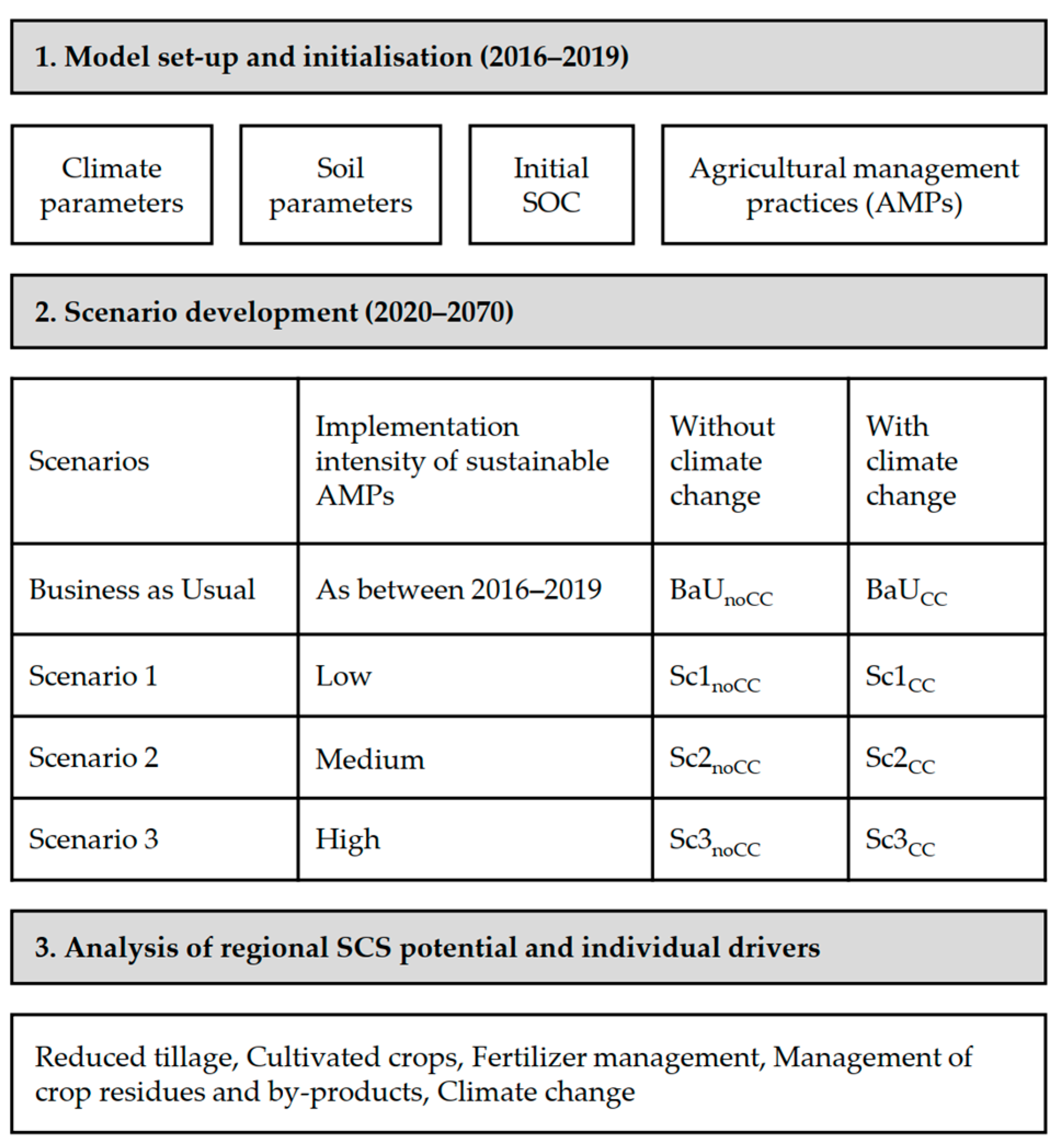
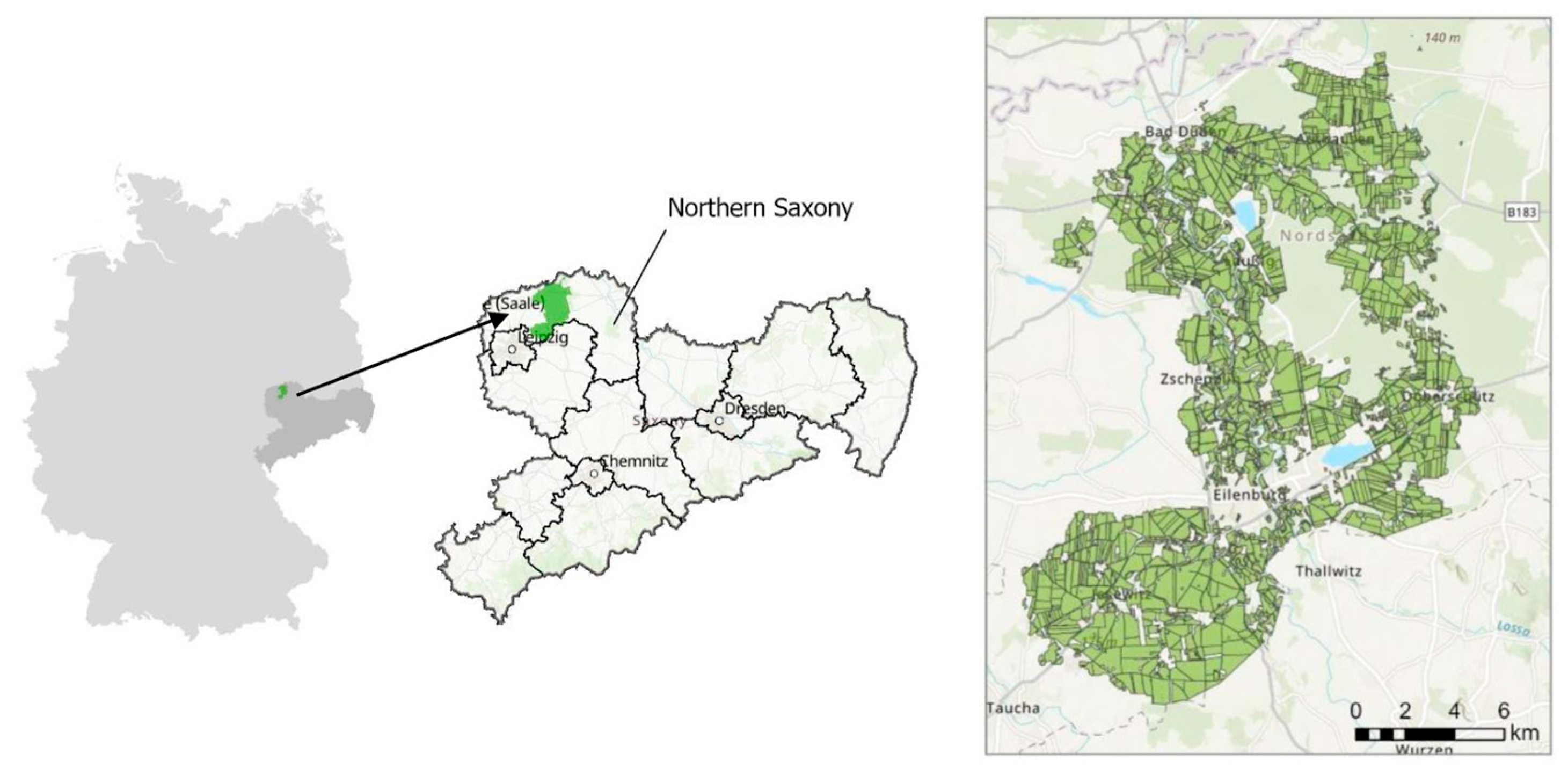

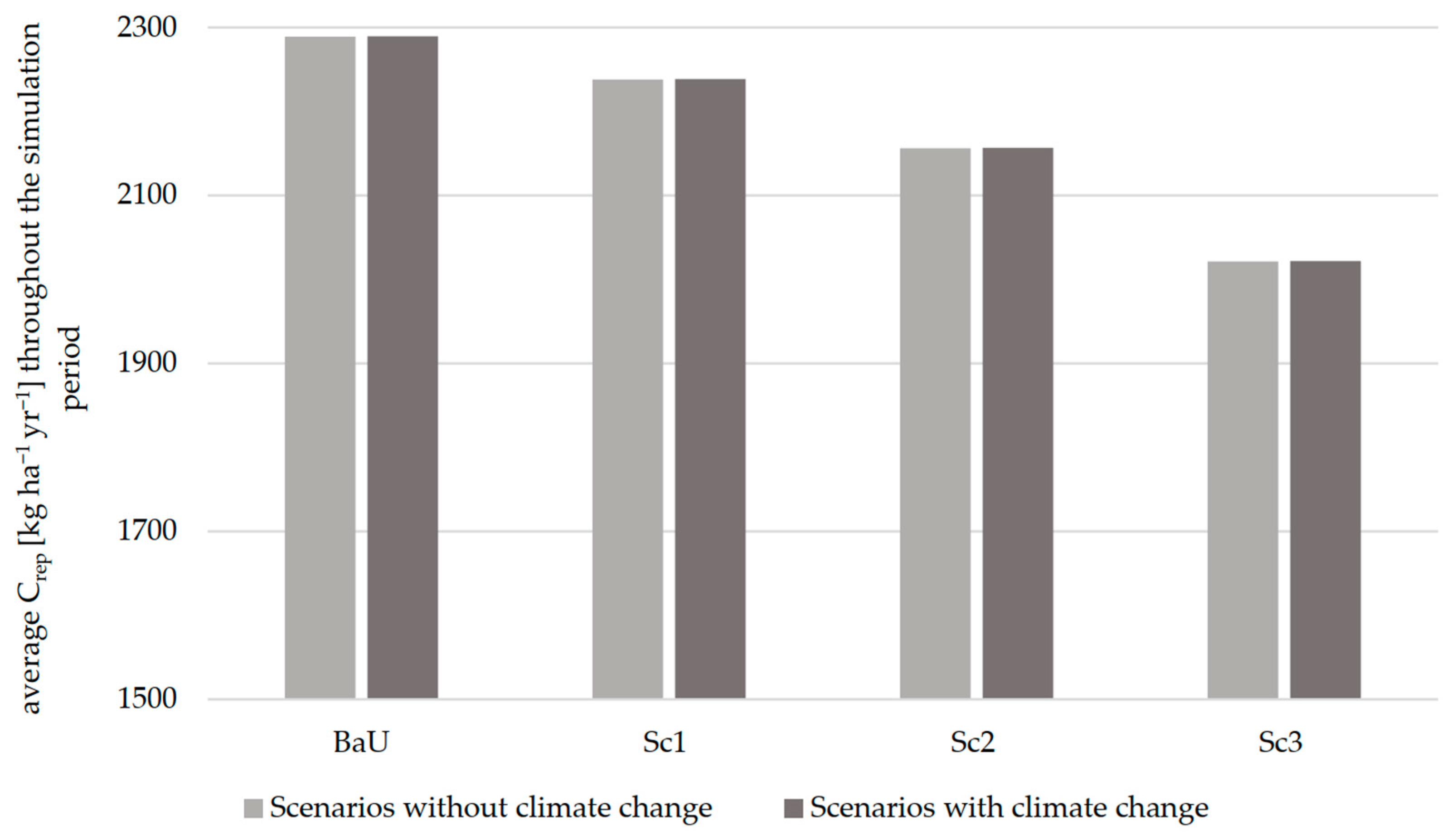
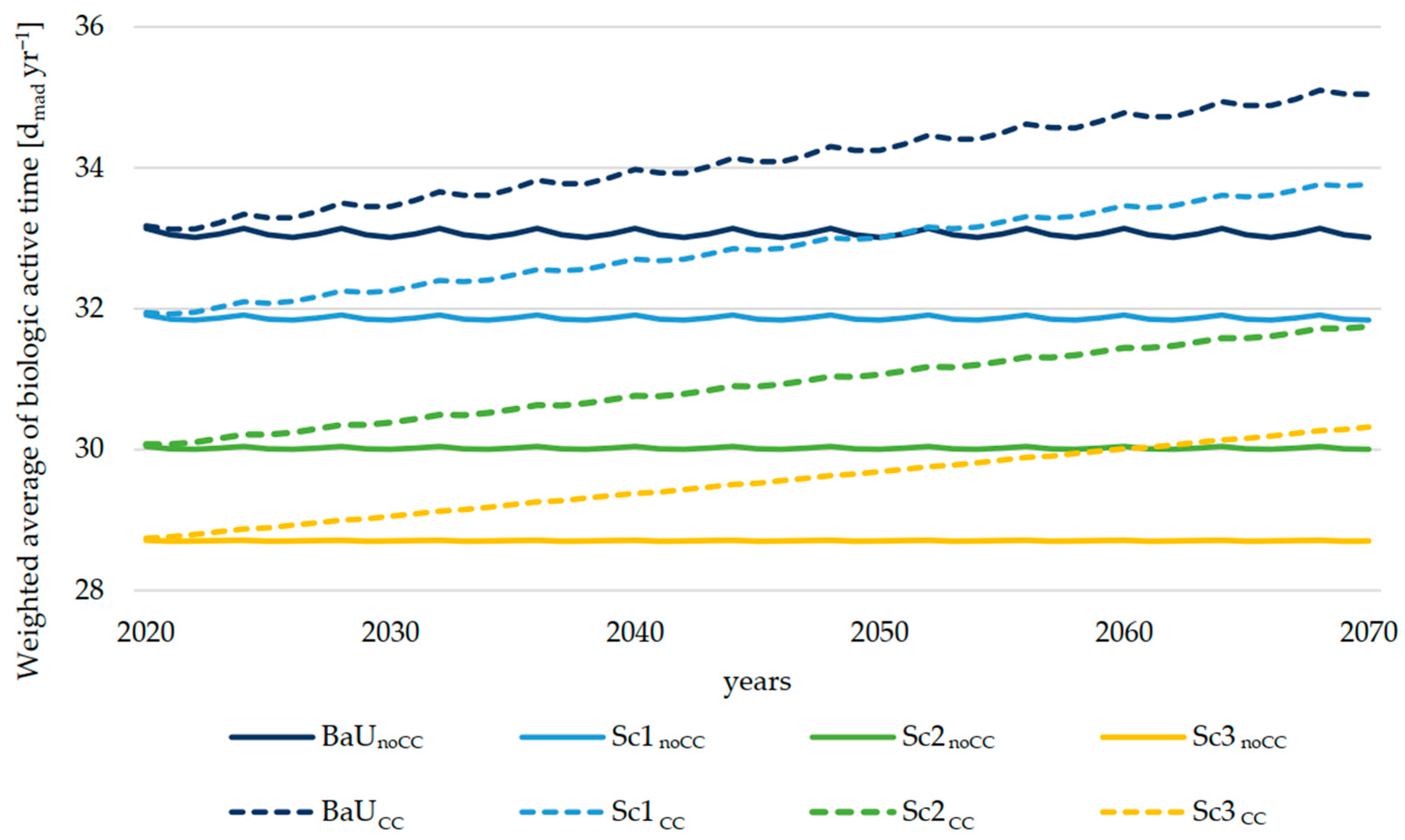
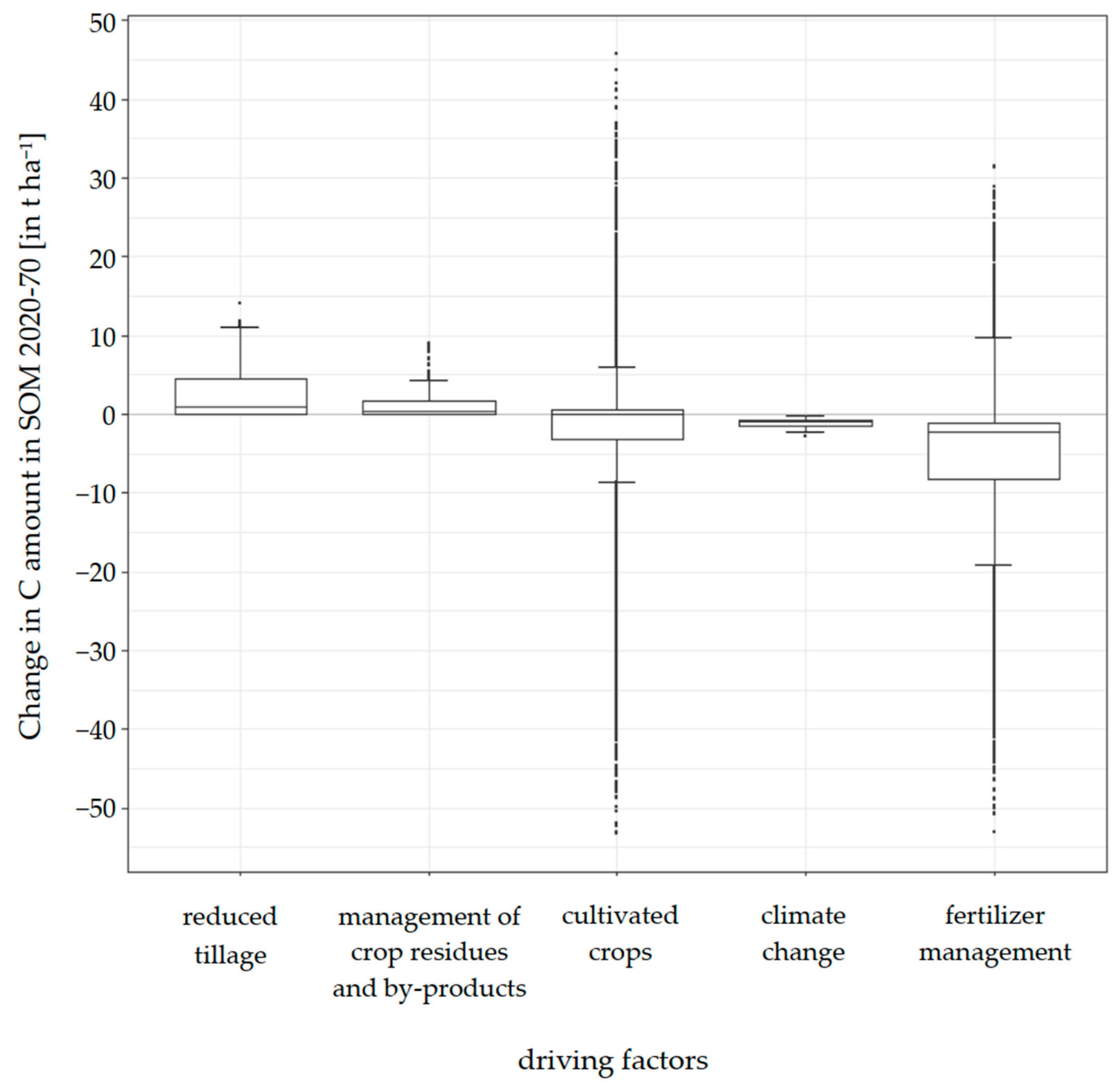
Disclaimer/Publisher’s Note: The statements, opinions and data contained in all publications are solely those of the individual author(s) and contributor(s) and not of MDPI and/or the editor(s). MDPI and/or the editor(s) disclaim responsibility for any injury to people or property resulting from any ideas, methods, instructions or products referred to in the content. |
© 2023 by the authors. Licensee MDPI, Basel, Switzerland. This article is an open access article distributed under the terms and conditions of the Creative Commons Attribution (CC BY) license (https://creativecommons.org/licenses/by/4.0/).
Share and Cite
Schwengbeck, L.; Hölting, L.; Witing, F. Modeling Climate Regulation of Arable Soils in Northern Saxony under the Influence of Climate Change and Management Practices. Sustainability 2023, 15, 11128. https://doi.org/10.3390/su151411128
Schwengbeck L, Hölting L, Witing F. Modeling Climate Regulation of Arable Soils in Northern Saxony under the Influence of Climate Change and Management Practices. Sustainability. 2023; 15(14):11128. https://doi.org/10.3390/su151411128
Chicago/Turabian StyleSchwengbeck, Lea, Lisanne Hölting, and Felix Witing. 2023. "Modeling Climate Regulation of Arable Soils in Northern Saxony under the Influence of Climate Change and Management Practices" Sustainability 15, no. 14: 11128. https://doi.org/10.3390/su151411128
APA StyleSchwengbeck, L., Hölting, L., & Witing, F. (2023). Modeling Climate Regulation of Arable Soils in Northern Saxony under the Influence of Climate Change and Management Practices. Sustainability, 15(14), 11128. https://doi.org/10.3390/su151411128





